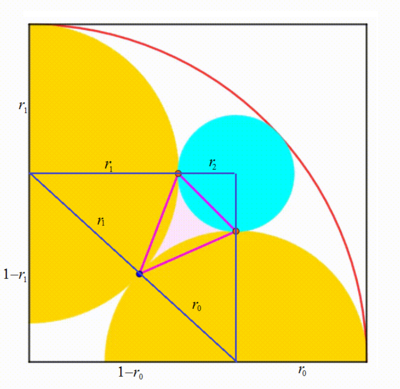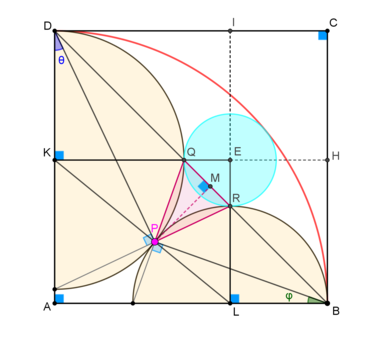Dynamic Geometry: P72
 The diagram shows a unit black square. A red quarter circle is drawn using the side of the square as the radius. Two yellow semicircles are drawn. Each center moves on one square's side so the semicircles are growing, shrinking and are tangent to each other at any moment. Then, we draw a cyan circle so it's tangent to the two yellow semicircles and internally tangent to the red quarter circle. We use the tangency points between the semicircles to draw a purple triangle. When its area is equal to
1
0
1
5
3
6
, the ratio of the larger yellow semicircle’s radius to the smaller yellow semicircle’s radius can be expressed as
q
p
, where
p
and
q
are coprime positive integers. Find
p
−
q
.
The diagram shows a unit black square. A red quarter circle is drawn using the side of the square as the radius. Two yellow semicircles are drawn. Each center moves on one square's side so the semicircles are growing, shrinking and are tangent to each other at any moment. Then, we draw a cyan circle so it's tangent to the two yellow semicircles and internally tangent to the red quarter circle. We use the tangency points between the semicircles to draw a purple triangle. When its area is equal to
1
0
1
5
3
6
, the ratio of the larger yellow semicircle’s radius to the smaller yellow semicircle’s radius can be expressed as
q
p
, where
p
and
q
are coprime positive integers. Find
p
−
q
.
The answer is 1.
This section requires Javascript.
You are seeing this because something didn't load right. We suggest you, (a) try
refreshing the page, (b) enabling javascript if it is disabled on your browser and,
finally, (c)
loading the
non-javascript version of this page
. We're sorry about the hassle.
2 solutions
I really like this setup, it is so simple and yet so rich, thank you for posting!

Let the radii of the right semicircle, left semicircle, and cyan circle be r 0 , r 1 , and r 2 respectively. By Pythagorean theorem , we note that:
( 1 − r 0 ) 2 + ( 1 − r 1 ) 2 1 − 2 r 0 + r 0 2 + 1 − 2 r 1 + r 1 2 1 − r 0 − r 1 ⟹ r 1 = ( r 0 + r 1 ) 2 = r 0 2 + 2 r 0 r 1 + r 1 2 = r 0 r 1 = 1 + r 0 1 − r 0
We also note that:
r 1 + r 2 r 2 ⟹ r 2 = 1 − r 0 = 1 − r 0 − r 1 = r 0 r 1 Note that 1 − r 0 − r 1 = r 0 r 1
If A c is the area of triangle of centers (blue) and A t is the area of triangle of tangent points \(purple) of three mutually externally tangent circles, then
\[\begin{align} A_t & = \frac {2r_0r_1r_2}{(r_0+r_1)(r_1+r_2)(r_2+r_0)} \blue{A_c} & \small \blue{\text{Note that }A_c = \frac {(1-r_0)(1-r_1)}2} \\ & = \frac {r_0^2r_1^2(1-r_0)(1-r_1)}{(r_0+r_1)(r_1+r_0r_1)(r_0r_1+r_0)} \\ & = \frac {r_0^2r_1^2(1-r_0-r_1+r_0r_1)}{r_0r_1(r_0+r_1)(1+r_0)(1+r_1)} \\ & = \frac {r_0r_1(2r_0r_1)}{(r_0+r_1)(1+r_0+r_1+\blue{r_0r_1)}} & \small \blue{\text{Again }1-r_0-r_1 = r_0r_1} \\ & = \frac {2r_0^2r_1^2}{(r_0+r_1)(2)} = \frac {r_0^2r_1^2}{r_0+r_1} = \frac {r_0^2r_1^2}{1-r_0r_1} \end{align} \]
Putting A t = 1 0 1 5 3 6 and rearrange:
1 0 1 5 ( r 0 r 1 ) 2 + 3 6 r 0 r 1 − 3 6 ( 3 5 r 0 r 1 − 6 ) ( 2 9 r 0 r 1 + 6 ) r 0 r 1 1 + r 0 r 0 ( 1 − r 0 ) 3 5 r 0 − 3 5 r 0 2 3 5 r 0 2 − 2 9 r 0 + 6 ( 5 r 0 − 2 ) ( 7 r 0 − 3 ) ⟹ r 0 = 0 = 0 = 3 5 6 = 3 5 6 = 6 + 6 r 0 = 0 = 0 = 5 2 , 7 3 Since r 0 r 1 > 0
Since r 0 and r 1 are interchangeable, these two values are the radii of both semicircle when A t = 1 0 1 5 3 6 . Therefore the ratio of large radius to the small radius of the semicircles is 7 3 ⋅ 2 5 = 1 4 1 5 ⟹ p − q = 1 5 − 1 4 = 1 .
So cool ! :)
Disclaimer: This is a lengthy and detailed approach.
Preliminaries
Let A B C D be the square. Denote the centers of the semicircles by K , L , their radii by r 1 , r 2 respectively and their intersection point by P . Denote by E the intersection of the perpendicular bisectors of A B and A D . Denote by Q , H , R and I the intersections of these lines with the semicircles and sides B C and C D , as seen in figure 1. Let J be the intersection of line A E with the red arc.
Let ∠ K D P = ∠ K P D = θ and ∠ L B P = ∠ L P B = φ (figure 2).
Points K , P and L are collinear, and ∠ A K L = 2 θ , ∠ A L K = 2 φ , thus 2 θ + 2 φ = 1 8 0 ∘ − ∠ K A L = 1 8 0 ∘ − 9 0 ∘ = 9 0 ∘ , hence θ + φ = 4 5 ∘ ( 1 ) Step 1: To prove that E is the center of the cyan circle (figure 1).
It is easy to see that Q and R belong to the diagonal B D of the square.
Moreover, Q E = K H − K Q − E H = K H − K Q − L B = 1 − r 1 − r 2 ( 2 )
Similarly, E R = I L − I E − R L = I L − D K − R L = 1 − r 1 − r 2 Hence the circle with center E and radius y = Q E = E R = 1 − r 1 − r 2 is tangent to both semicircles.
Furthermore, E J = A J − A E = A J − K L = 1 − ( r 1 + r 2 ) Thus, E is the center of the cyan circle tangent to the semicircles and the red arc.
Step 2: To establish a relation for r 1 and r 2
By Pythagorean theorem on △ A K L we have K L 2 = A K 2 + A L 2 ⇒ ( r 1 + r 2 ) 2 = ( 1 − r 1 ) 2 + ( 1 − r 2 ) 2 which gives r 1 + r 2 = 1 − r 1 r 2 ( 3 )
Step 3: To find expressions for the area of △ P Q R (figure 3)
 Figure 3
Let
P
M
be a height of
△
P
Q
R
.
Figure 3
Let
P
M
be a height of
△
P
Q
R
.
We notice that P D = 2 r 1 cos θ and P B = 2 r 2 cos φ .
Hence for the area, [ P Q R ] = 2 1 Q R ⋅ P M = 2 1 ( 2 Q E ) ⋅ P D sin ( 4 5 ∘ − θ ) = ( 2 ) 2 2 ( 1 − r 1 − r 2 ) ⋅ ( 2 r 1 cos θ ) sin ( 4 5 ∘ − θ ) = = ( 3 ) , ( 1 ) 2 ( r 1 r 2 ) r 1 cos θ sin φ ⇒ r 2 [ P Q R ] = 2 ( r 1 r 2 ) 2 cos θ sin φ ( 4 )
In the same time, [ P Q R ] = 2 1 ( 2 Q E ) ⋅ P B sin ( 4 5 ∘ − φ ) = ( 2 ) , ( 1 ) 2 2 ( 1 − r 1 − r 2 ) ⋅ ( 2 r 2 cos φ ) sin θ = = ( 3 ) 2 ( r 1 r 2 ) r 2 cos φ sin θ ⇒ r 1 [ P Q R ] = 2 ( r 1 r 2 ) 2 cos φ sin θ ( 5 )
Step 4: To deduce an equation for x = r 1 r 2 and solve it
Adding ( 4 ) and ( 5 ) , ( r 1 + r 2 ) [ P Q R ] = 2 ( r 1 r 2 ) 2 ( cos θ sin φ + cos φ sin θ ) ⇒ ( 3 ) ( 1 − r 1 r 2 ) 1 0 1 5 3 6 = 2 ( r 1 r 2 ) 2 sin ( θ + φ ) ⇒ ( 1 ) ( 1 − r 1 r 2 ) 1 0 1 5 3 6 = 2 ( r 1 r 2 ) 2 sin ( 4 5 ∘ ) ⇒ ( 1 − r 1 r 2 ) 1 0 1 5 3 6 = 2 ( r 1 r 2 ) 2 2 2 ⇒ 1 0 1 5 ( r 1 r 2 ) 2 + 3 6 r 1 r 2 − 3 6 = 0 ⇒ r 1 r 2 > 0 r 1 r 2 = 3 5 6
Step 5: To find r 1 , r 2 and hence their ratio
Since r 1 r 2 = 3 5 6 , ( 3 ) ⇒ r 1 + r 2 = 3 5 2 9 , hence r 1 , r 2 are the roots of the quadratic equation x 2 − 3 5 2 9 x + 3 5 6 = 0 , i.e. r 1 = 7 3 a n d r 2 = 5 2 or vice versa.
Hence the ratio of the larger yellow semicircle’s radius to the smaller yellow semicircle’s radius is 5 2 7 3 = 1 4 1 5 For the answer, p = 1 5 , q = 1 5 , thus, p − q = 1 .